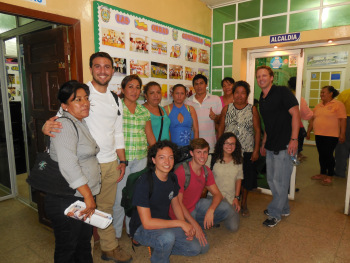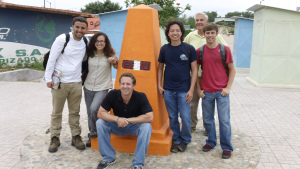RPCV Dana Rasch (2009-2010) founded the Las Mercedes project in 2009 to support the construction of a health clinic in the community Las Mercedes, located in the city of Huaquillas, Ecuador. Friends of Ecuador helped in the initial stages of the project, until it obtained its own 501c3 status. Here is his recent post about how the project is doing:
Monday, May 27th, 2013
I arrived in Ecuador on May 13th and, fortunately, I have hardly had a moment to rest over the past couple weeks. Most of my time has been dedicated to the preliminary project evaluation that was completed last week by Engineers without Borders (EWB), an international NGO that carries out infrastructure projects around the globe. The first step for EWB in any new project is to complete an on-site evaluation to determine which project they will carry out, and if that project is feasible. This evaluation includes a survey of the land as well as the completion of a community-based needs assessment that consists of house-to-house interviews. Overall, their visit was a tremendous success! If we can put all the pieces together, then our non-profit, EWB, the local government, and the residents of Las Mercedes can execute a collaborative project that will have tremendous impact in the community. I’m excited to share the details of the proposed project, but let me start from the beginning…
On Saturday, May 18th the EWB team arrived in Guayaquil. Edward, my engineer friend from Machala, and I received them at the airport. The team consisted of 4 University of Miami engineering students, Miguel, Maria, Daniel, and Joey Ray, and a professional civil engineer, Peter, who has worked in Ecuador for over 20 years. That Saturday night Peter treated everyone to a fancy meal at a nice restaurant in Guayaquil. The next day, Sunday, May 19th, we headed to Huaquillas in a van the team rented in order to arrive in time for the 7pm community meeting. The objective of the community meeting was not only to introduce the students to the residents, but to understand the needs of the community since the focus of this project is to address a social problem identified by community members. The residents came out in force and we provided an open space for anyone to talk about community issues. Throughout the night a number of issues were discussed including the lack of infrastructure in the Las Mercedes elementary school to the need for the installation of a sewage system. Ultimately, it was clear that the sewage system was the project with the highest priority since the septic tanks were falling apart and becoming unserviceable (not to mention extremely toxic for the environment). Putting in a sewage system, however, is extremely expensive and is monetarily beyond the scope of EWB, our non-profit, and the residents of Las Mercedes. Nevertheless, we thanked everyone for their participation and told them that we would be hanging around the community all week to carry out the preliminary evaluations to determine the feasibility of various projects.

On Monday morning, May 20th, we were supposed to meet with the Mayor to kick off the week, but at the last minute the meeting was moved to the afternoon, so we had to make some quick adjustments to the schedule. In the end, the change was actually a blessing – let me explain. After making a few phone calls, we were able to move the Las Mercedes and water treatment plant tour up to 9am. Alghough the tour went along well, many unexpected challenges popped up as we assessed the possibility of putting in a sewage or drainage system. These difficulties definitely made us doubt the feasibility of either or both projects. Later on that day, at around 11am, Geovanny, the city lawyer, informed me that the Mayor was going to call me in a minute with some big news. I was a little worried. The Mayor called and after exchanging a few pleasantries, he told me that the money was finally approved by the state government to put in a sewage system in Las Mercedes. This was amazing news! Essentially, the local government is now going to install a sewage system. With this news in hand, we re-oriented our plans quickly and decided that the collaborative project could entail connecting each house to the sewage system since the local government will only put in the system itself and not connect the houses. The local government officials thought this idea was fantastic and was also quickly approved by the local residents, namely the President of Las Mercedes, Nancy Piedra.

At 2pm, we met with the Mayor of Huaquillas and presented the idea. After a little explaining and a bit of politicking, we all agreed that the installation of a complete sewage system would be the project that would be carried out in the community. To connect a house to the sewage system can cost anywhere between $150-200, but as a collaborative project, we can all work together to reduce that cost to practically the bare minimum and insure that every connection works as intended. Needless to say, I am very excited about this project, as are the residents of Las Mercedes.
We started the evaluation on Tuesday, May 21st with the project idea in hand. Edward arrived early in the morning with his surveying equipment and we broke into two teams. Peter, Miguel, and Maria went with Edward to complete the surveying of the land. The other team, consisting of Daniel, Joey and I, worked on the community-based needs assessment questionnaire. Later that day, while the surveying group was working hard, my group met with community residents to finalize the questionnaire for the door-to-door assessment. After a few heated debates, which I loved, we finalized the survey.
The land surveying group finished ahead of schedule freeing them up to help out with the application of the questionnaire so on Wednesday, May 22nd, we began the survey. The community members did an amazing job leading everything up – they were running around, talking like sociologists, and showing off their skills, making me feel quite proud. In the end, we collected 109 surveys in only 1 ½ days!
After we finished the survey early Thursday afternoon, we headed up to the Ecuador/Peru border to pick up some knick-knacks. As usual, the border was filled with people selling and buying everything from birds, to baby goats, to bootleg hats. After our border adventure everyone headed back to the hotel to rest for a bit. Later that night we headed to Las Mercedes for a party at the President’s house. The President and her team prepared an amazing dinner for everyone and most important, no one got sick! After eating, we danced for quite a while on the President’s patio and Miguel showed everyone a few of the moves he learned growing up as a Salsa king in Miami. By 10pm, everyone was pretty tired so we headed back to the hotel to rest up.
On Friday, May 24th, the EWB team headed back to Guayaquil to catch their flight the next day. Unfortunately I couldn’t accompany them, but I was able to say goodbye at the hotel. Even though I took a nap about an hour after they left due to fatigue from the week, I am going to miss them. The next step in the project is for them to submit a proposed plan to EWB headquarters for approval and within two months we will sign an agreement between all the participants – EWB, our non-profit, the residents, and the Mayor. Needless to say, I am very excited about the prospects and if we can carry out this project in the coming year, the impact in the community will be incredible. As I have noted previously, typhoid fever is common in the community, but with improved infrastructure – namely, a complete sewage system – the typhoid rate will be considerably decreased.
In addition to the sewage project, things are definitely moving in the right direction for the health center. This coming week we are finishing up the paperwork to hand over the center to the health ministry. If everything goes as planned, the health ministry will equip it and provide a full medical staff. For now, this is my primary focus and hopefully I will have an update soon with some great news. For the moment, please enjoy the pictures below!








